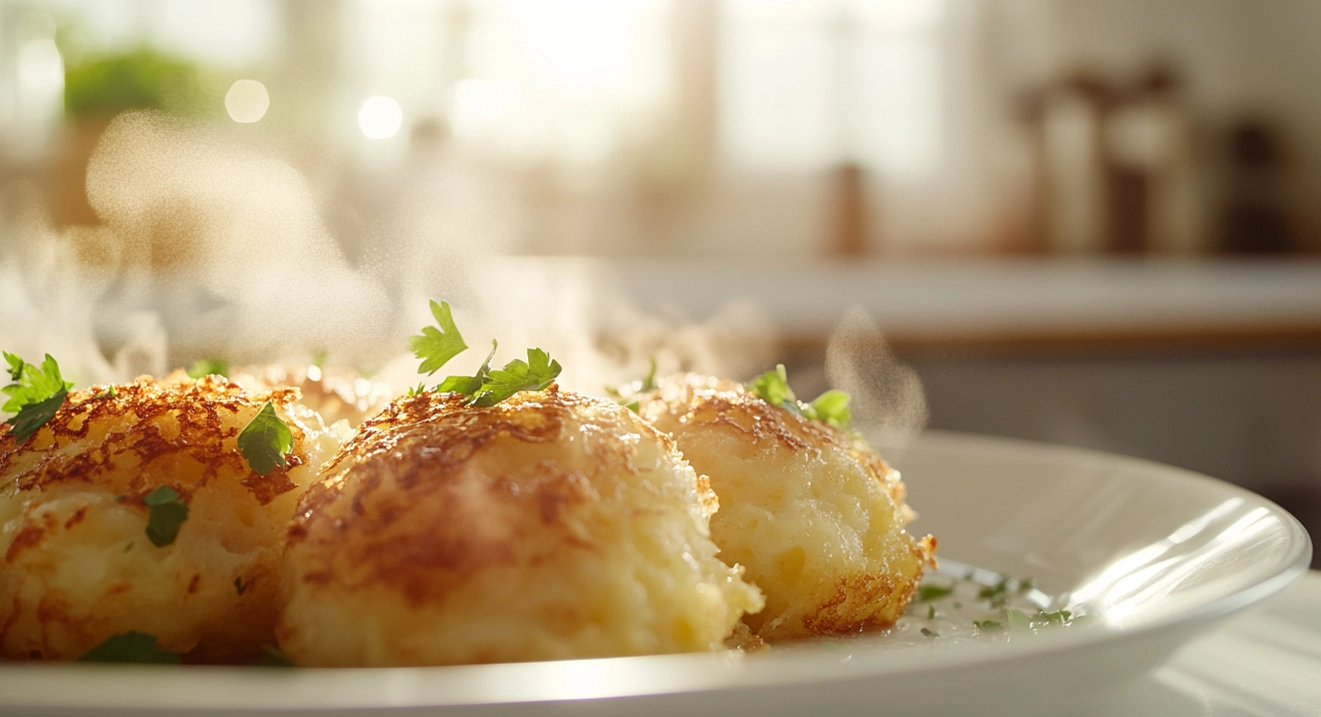
Table of Contents
Introduction
Hash browns are a beloved breakfast dish made from grated or finely chopped potatoes, which are then pan-fried until crispy. Known for their deliciously crispy exterior and soft interior, they have become a staple in many breakfast menus worldwide.
A Brief History
The origins of hash browns can be traced back to the United States in the late 19th century. “Hash” comes from the French word hacker, meaning “to chop.” Initially, hash browns were a way to use leftover potatoes, typically paired with other foods. Over time, their popularity grew as a distinct breakfast item, particularly with the rise of American diner culture in the early 20th century. Today, they are a common feature at breakfast tables, especially in North America.
Why Hash Brown Are a Popular Breakfast Choice
Their crispy texture, golden-brown color, and versatility make them an ideal complement to other breakfast items, such as eggs, bacon, and sausage. Furthermore, they are quick and easy to make, offering a satisfying, hearty meal. Whether served as a side or a main dish, hash browns are a comforting, filling choice that many enjoy first thing in the morning.
The Essential Ingredients
You’ll need just a few essentyou’llgredients to make perfect hash brown. While the recipe varies, these are the essentials that contribute to the crispy and delicious results.
Potatoes: The Core Ingredient
Potatoes are the star of the dish. Russet potatoes are typically preferred for hash brown due to their starchy nature, which results in a crispier texture when fried. The potatoes should be peeled and grated or finely chopped. The moisture in the potatoes must be removed before cooking to ensure they fry up crispy rather than becoming soggy.
Oil or Butter: The Cooking Fat
The choice of cooking fat plays a key role in achieving the right texture and flavor. Butter provides a rich, savory flavor, while oil, especially vegetable or canola oil, offers a higher smoke point and crispiness. Many cooks combine both to get the best of both worlds—flavor from the butter and crispiness from the oil.
Salt and Pepper: The Basic Seasoning
Salt and pepper are the most straightforward yet essential seasonings for hash brown. They enhance the natural flavor of the potatoes and provide the necessary seasoning for a satisfying dish. You can also experiment with other herbs, such as garlic powder, onion powder, or paprika, but salt and pepper remain the foundational seasonings that make hash browns delicious.
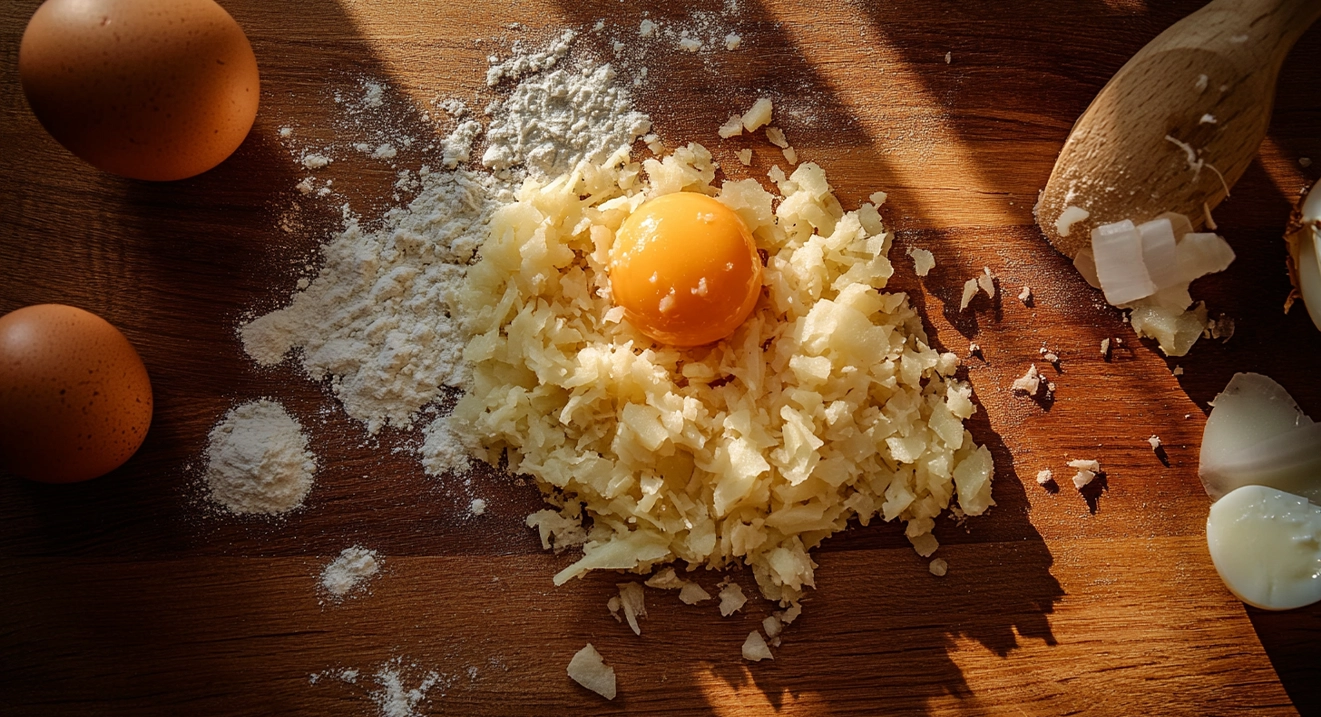
Optional Ingredients for Customizing Hash Browns
While the basic hash brown recipe is delicious, adding a few optional ingredients can take the dish to the next level, allowing you to personalize it with extra flavor and texture.
Onions: Adding Sweetness and Crunch
Onions are a great addition to hash brown, offering sweetness and a satisfying crunch. They can caramelize slightly when sautéed before being added to the potatoes, enhancing their natural sweetness. Whether you use yellow, red, or green onions, they bring an extra layer of flavor that complements the potatoes well.
Garlic: For a Flavorful Kick
Garlic is an excellent way to add a savory, aromatic kick to hash browns. Minced garlic can be sautéed with the onions or directly added to the potatoes before frying. Its intense and rich flavor infuses the potatoes, providing depth and complexity to the dish.
Cheese: Adding Richness and Texture
Cheese can elevate hash browns by adding richness and a creamy texture. Cheddar, mozzarella, or even parmesan are popular choices. Cheese can be mixed directly into the potatoes before cooking or sprinkled on top toward the end of frying for a melty, gooey finish. The cheese not only enhances flavor but also contributes to a delightful texture.
Herbs: Freshness and Aromatics
Herbs such as parsley, chives, thyme, or rosemary add freshness and aromatic qualities to hash browns. Fresh herbs can be stirred into the potatoes before frying or sprinkled on top after cooking. These herbs bring a burst of color and an added layer of complexity, perfect for customizing the flavor profile of your hash browns.
How to Prepare Potatoes for Hash Browns
Proper potato preparation is key to achieving crispy, golden hash browns. The following steps will guide you through getting the potatoes ready for cooking.
Choosing the Right Type of Potato
The type of potato you choose can significantly affect the texture of your hash browns. Russet potatoes are the best option because they have a high starch content, which helps achieve a crispier texture when fried. After cooking, their fluffy interior and dry exterior make them ideal for hash browns. Avoid waxy potatoes, like red or new potatoes, as they contain more moisture and are less likely to crisp up.
Rinsing and Grating the Potatoes
After selecting the right potatoes, the next step is grating them. Use a box grater or a food processor to grate the potatoes into fine shreds. The smaller the shreds, the crispier the hash browns will be. Once grated, place the potatoes in a large bowl of cold water to rinse off excess starch. Rinsing helps prevent the shreds from sticking together and ensures they fry evenly.
Removing Excess Moisture
Removing excess moisture is one of the most critical steps in preparing potatoes for hash browns. After rinsing the grated potatoes, drain them well and use a clean kitchen towel or paper towel to squeeze out as much water as possible. This step is crucial for achieving crispy hash browns, as excess moisture will cause them to become soggy when frying. The drier the potatoes, the crispier your hash browns will be.
Cooking Techniques
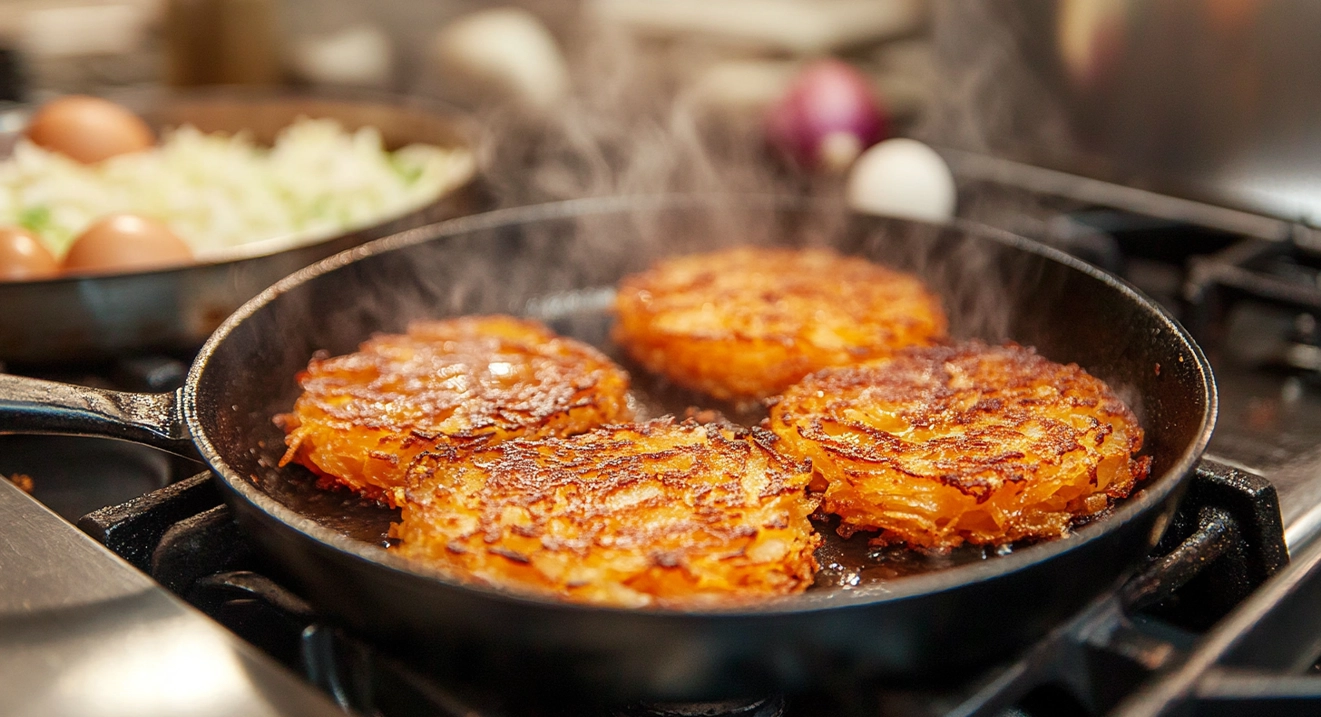
The cooking method you choose and how you handle the heat will play a significant role in achieving perfectly crispy hash browns. Here are some tips to ensure your hash browns turn out golden brown and delicious.
Pan-Frying vs. Deep-Frying
There are two standard methods for cooking hash browns: pan-frying and deep-frying.
- Pan-frying is the most popular method for cooking hash browns. It involves using a generous amount of oil or butter in a skillet to fry the grated potatoes until golden and crispy. Pan-frying gives you control over the heat and texture, and you can quickly flip the hash browns to ensure even cooking.
- Deep-Frying: While not as common, deep-frying produces ultra-crispy hash browns. The potatoes are fully submerged in hot oil, ensuring even cooking and a crunchy exterior. Deep-frying is faster but requires more oil and a deep fryer or large pot.
Both methods can yield crispy hash browns, but pan-frying is often the go-to for home cooks.
Achieving Crispy Texture
Using enough cooit’s fat to achieve a crispy texture and avoid overcrowding the pan is crucial. When the potatoes are too close together, they steam rather than crisp up. Instead, cook the hash browns in batches if necessary. Another key to crispiness is ensuring the oil is hot before adding the potatoes. The oil should sizzle when the potatoes hit the pan, helping to form a golden crust. Also, avoid moving the potatoes too much while they cook; let them create a crust on one side before flipping them to the other side.
Cooking Time and Temperature
The ideal cooking time for hash browns depends on their thickness and how crispy you want them. It typically takes 4-6 minutes per side on medium-high heat to achieve a golden-brown, crispy texture. The oil should be hot enough to fry the potatoes quickly but not smoking. If the heat is too high, the outside may burn before the inside cooks through. If it is so low, the hash browns may become soggy. Adjust the heat as needed and monitor the hash browns to ensure they cook evenly for best results.
Variations of Hash Browns Around the World
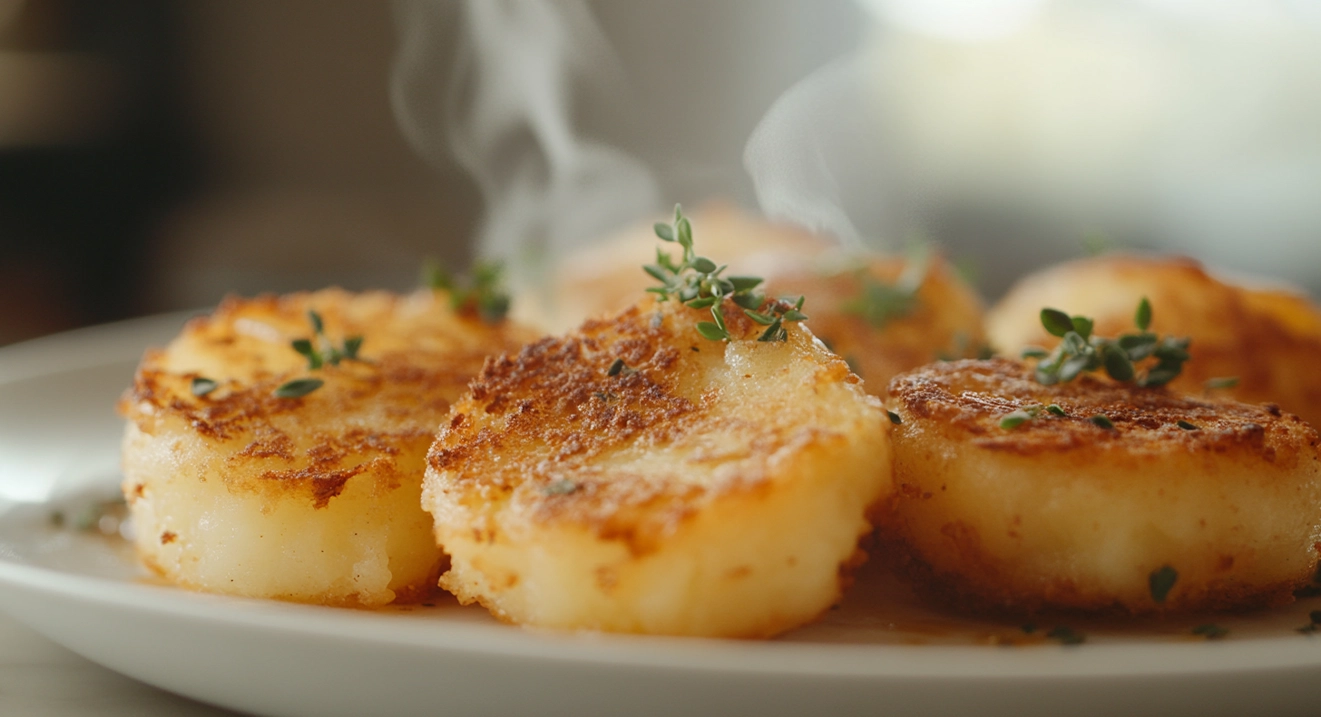
While hash browns are popular in many countries, their preparation and ingredients can vary widely. Let’s explore the global takes on this classic breakfast dish, from American-style to European variations.
American vs. European
- American Hash Browns: In the United States, hash brown are typically made from grated or shredded potatoes pan-fried to a crispy golden brown. They are often served as a side dish for breakfast alongside eggs, bacon, or sausage. The American version focuses on simplicity and crispiness, with minimal seasoning—salt and pepper being the essentials.
- European Hash Browns: In Europe, the concept of hash browns takes on different forms. For example, in the UK, “ha”h brown” o” ten refer to a smaller, thicker patty made of mashed or grated potatoes, which is then fried. In countries like Germany, a dish called “Re” kuchen” o” “Po” to Pancakes” i” is made by combining grated potatoes with onions and flour, then frying the mixture into small, crispy cakes. In France, a dish called “Po”mes de Terre Sarladaises” f” features sliced potatoes sautéed in duck fat with garlic and herbs, offering a different flavor profile than the traditional hash brown.
Innovative Twists on the Classic Hash Brown
While the traditional hash brown is beloved for its simplicity, there are many ways to add an innovative twist to this classic dish.
- Sweet Potato Hash Browns: Using sweet potatoes instead of regular russet potatoes creates a naturally sweet, nutrient-packed alternative. Sweet potato hash browns are just as crispy but offer a slightly different flavor and texture.
- Veggie-Infused Hash Browns: For added flavor and nutrition, vegetables like spinach, zucchini, or bell peppers can be mixed into the grated potatoes before frying. This variation adds color and a burst of freshness to the dish.
- Cheese-Stuffed Hash Browns: Some cooks stuff their hash brown with cheese, creating a melty, indulgent center. This twist is often achieved by placing a layer of cheese between two layers of grated potatoes before frying.
- Spiced Hash Browns: Adding spices such as cumin, smoked paprika, or chili flakes to the grated potatoes before frying can infuse hash brown with exciting flavors, making them a unique and bold option for breakfast or brunch.
Tips for Perfect Hash Brown Every Time
Achieving the perfect hash brown requires a few key tips and tricks. Follow these steps to ensure your hash browns turn out crispy, golden, and delicious every time.
The Secret to Crispy Hash Browns
- Remove Excess Moisture: The most critical factor in getting crispy hash brown is to remove as much moisture as possible from the grated potatoes. After rinsing, pat the potatoes dry with a clean kitchen towel or paper towel. The drier the potatoes, the crispier your hash browns will be.
- Use the Right Amount of Fat: Ensure you use enough oil or butter in the pan. The fat helps create a crispy golden crust. Don’t on it—about 2 to 3 tablespoons of oil per batch should be enough for a nice, crisp result.
- DonDon’tercrowd the Pan: Overcrowding the pan traps moisture and causes the hash browns to steam rather than fry. Cook them in batches if needed, giving them plenty of room to crisp up.
- Hot Pan and Oil: Ensure the oil is hot enough before adding the potatoes to the pan. When the oil sizzles upon contact with the potatoes, the pan is at the right temperature for frying. This helps the hash brown cook evenly and form a golden-brown crust.
Common Mistakes to Avoid
- Not Drying the Potatoes Properly: One of the most common mistakes when making hash browns is failing to remove excess moisture from the grated potatoes. This results in soggy hash browns that don’t pick up correctly. Make sure to squeeze out as much moisture as you can.
- Using the Wrong Type of Potato: Using waxy potatoes (like red or new potatoes) can result in hash brown that are soft and not as crispy. Stick to starchy potatoes, such as russets, for the best texture.
- Cooking on Low Heat: Cooking hash brown on low heat will cause them to cook too slowly and may become soggy. Medium-high heat is ideal for a crispy exterior and a cooked interior.
- Flipping Too Early or Too Often: Resist the urge to flip your hash brown too soon. Let them cook on one side for about 4-5 minutes until golden brown before flipping. Constant flipping will prevent the crust from forming and may make the hash browns fall apart.
- Not Enough Seasoning: Hash brown need seasoning to bring out their flavor. Remember to add salt and pepper, and feel free to experiment with other seasonings, such as garlic powder, paprika, or onion powder, to enhance the flavor.
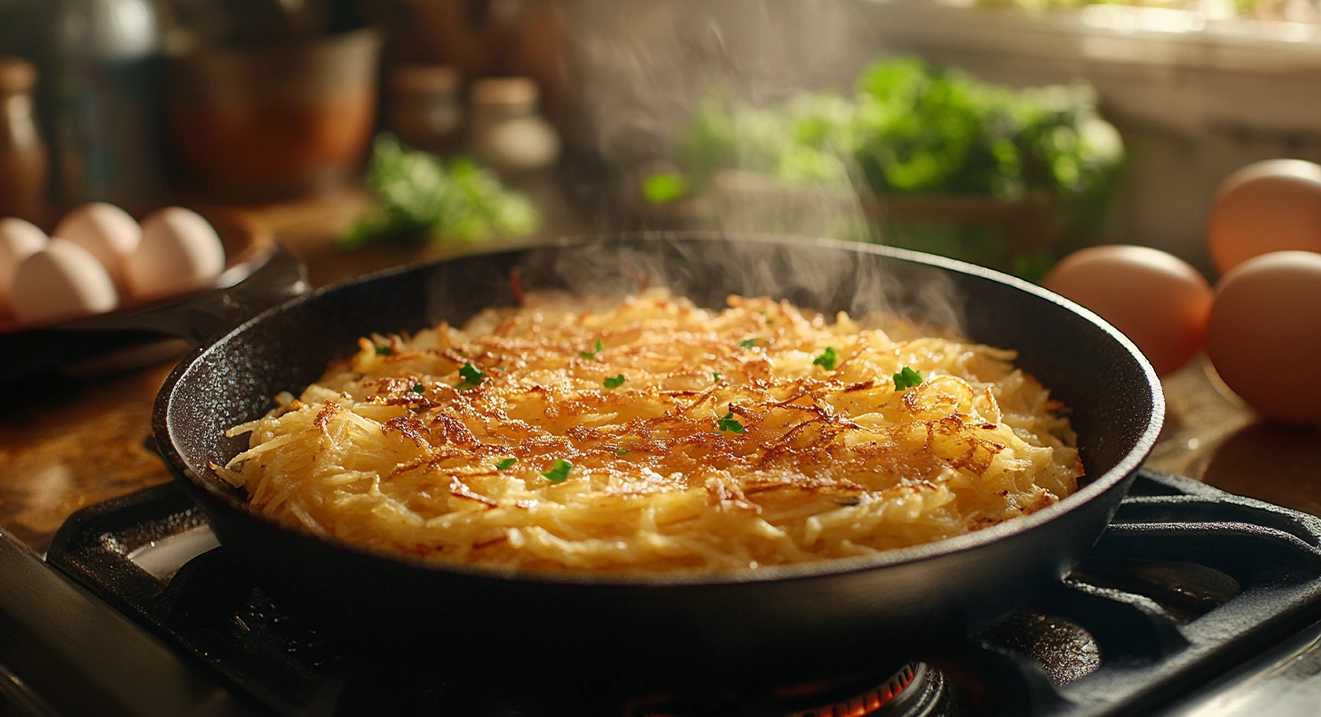
FAQs
What are hash brown made of?
Hash browns are typically made from grated or finely chopped potatoes, which are then pan-fried or deep-fried until golden and crispy. They may be seasoned with salt, pepper, and other spices and cooked with oil or butter to achieve a crispy texture.
What is the main ingredient in a hash?
The main ingredient in the hash is usually potatoes. The dish may include other ingredients such as meat (e.g., corned beef), onions, bell peppers, and seasonings. While there are many variations of hash, the potatoes are considered the core component.
What are the ingredients in hash brown sticks?
Hash brown sticks are similar to regular hash brown but in stick form. The main ingredients include grated potatoes, oil or butter, salt, and pepper. Some recipes may add seasonings or ingredients such as garlic, onion powder, or cheese. The potatoes are often shaped into sticks before frying for a crispy exterior.
What are the ingredients in McDonald’s browns?
McDonald’s brown are made from shredded potatoes, vegetable oil, and a blend of seasonings. The specific ingredients include:
- Potatoes
- Vegetable oil (canola oil, corn oil, soybean oil)
- Salt
- Dextrose (a form of sugar)
- Sodium acid pyrophosphate (to preserve color)
- Natural flavoring
Conclusion
timeless and versatile breakfast dish enjoyed around the world. Whether you prefer them crispy and golden, mixed with flavorful ingredients, or served innovatively, hash browns offer endless possibilities for customization. By using the right ingredients, cooking techniques, and a few helpful tips, you can create perfect hash browns every time. Whether you’re a simple side dish or getting creative with toppings and flavors, hash browns remain a beloved and satisfying part of any meal.
For More Delicious Recipes, Follow Us at QuickyCookRecipes.com!
Follow Us on Facebook, Pinterest, or Instagram for More Fast & Easy Meals!
